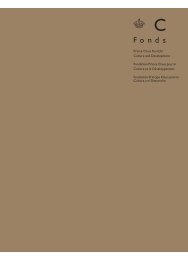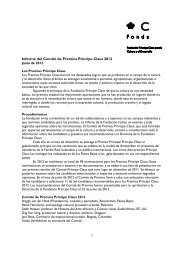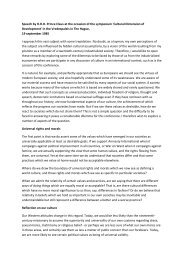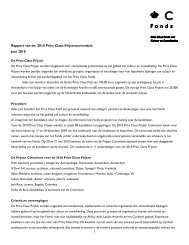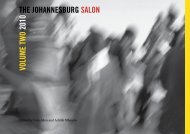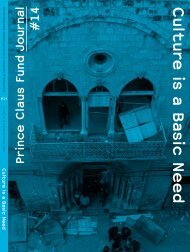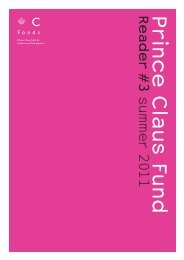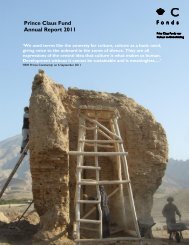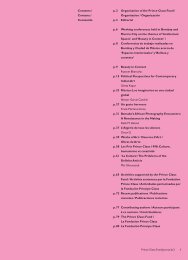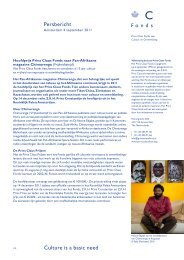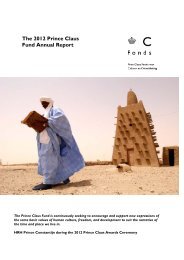Here - Prince Claus Fund
Here - Prince Claus Fund
Here - Prince Claus Fund
You also want an ePaper? Increase the reach of your titles
YUMPU automatically turns print PDFs into web optimized ePapers that Google loves.
Oscar Wilde’s dictum that nothing succeeds like excess’; on another, as combining<br />
‘beauty with vulgarity’. 8 Actively eschewing ‘the bourgeois idiom of<br />
understatement and tastefulness’ 9 , prior to Versace’s untimely death in July<br />
1997 he produced clothing that was overtly opulent, and loudly eye-catching; in<br />
fact, not dissimilar to many of the garments currently being made by some of<br />
South Africa’s rural traditionalists.<br />
Figure 3<br />
Breastplate, Limpopo Province, South Africa,<br />
25 x 29 cm, private collection, Cape Town<br />
photo A. van Eeden<br />
Economic Necessity vs. Aesthetic Choice<br />
Because of the realties of massive unemployment, especially in rural South<br />
Africa, it would be easy to dismiss as absurd the suggested comparison between<br />
Versace’s clothing and the dress worn by these local traditionalists. In contrast<br />
to leading countries in the west, South Africa’s private wealth is concentrated in<br />
the hands of a very small number of people. 10 By the early 1990s, fewer than ten<br />
per cent of the country’s population seeking to enter the labour market<br />
managed to find work in the formal job sector, 11 while estimates of employment in<br />
the informal sector ranged from ten to 29 per cent. 12 Particularly in rural areas,<br />
people with low skill and educational levels often fail to generate any income at<br />
all, and those who do find employment commonly earn a tenth of the wages earned<br />
by workers employed in the manufacturing sector in urban areas. 13<br />
Frightening though these statistics may be, they should not encourage one to<br />
assume that the crafted garments currently produced by women from<br />
economically marginalised communities living in the country’s rural periphery are<br />
inevitably shaped by an aesthetics of necessity rather than an aesthetics of<br />
choice. Even though some researchers have cautioned – no doubt rightly – that<br />
the recycling practices of impoverished communities 14 are sometimes far from<br />
ennobling or liberating, let alone deliberate comments on the global circulation of<br />
cheap commodities, questions regarding the creative agency of African<br />
producers are never as simple or as straightforward as they might seem at first<br />
sight. On the contrary, as Appiah notes in his consideration of contemporary<br />
African creativity, ‘despite the overwhelming reality of economic decline; despite<br />
unimaginable poverty; despite wars, malnutrition, disease and political instability,<br />
African cultural productivity grows apace …’ 15<br />
In South Africa, where impoverished rural traditionalists have shown a growing<br />
interest in using plastic, rather than glass beads since the early 1970s, it is quite<br />
common for outsiders to ‘misread’ the reasons for this development. Because<br />
these plastic beads are now manufactured locally by a factory linked to Pretoria<br />
Distributors, a wholesaling group that sells beads to other wholesalers<br />
throughout the country, there is a vast difference in the local price of plastic<br />
and glass beads. (The latter are still imported from various centres in Europe and<br />
in the east). Today, 250 grams of white glass beads retails for about R50, while a<br />
large bag of plastic beads costs about R10. 16 Unlike glass beads, which differ in<br />
price depending on colour – for example, pink beads are so expensive to manufacture<br />
that those currently being produced tend to be a milky, watered-down<br />
camomile colour – plastic beads all retail for the same, comparatively low price.<br />
89 <strong>Prince</strong> <strong>Claus</strong> <strong>Fund</strong> Journal #10a Popular Design and Crafts



